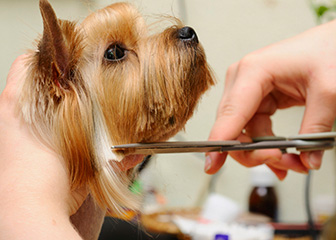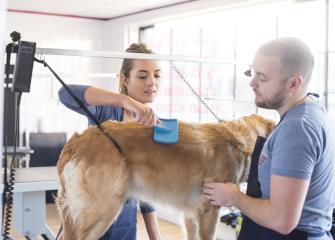Animal Care and Service Worker
Animal Care and Service Worker
Does this career fit your work personality?
Begin The Career Assessment Test- Best Fitting Careers
- Work Personality Strengths
- Work Style Preferences
- and more
What Animal Care and Service Workers Do
Animal care and service workers attend to or train animals. Working with pets and other nonfarm animals, these caretakers and trainers feed, groom, and exercise the animals or teach them to respond to human commands.
Duties
Animal care and service workers typically do the following:
- Give food and water to animals
- Clean equipment and the living spaces of animals
- Monitor animals and record details of their diet, physical condition, and behavior
- Examine animals for signs of illness or injury
- Exercise animals
- Bathe animals, trim nails, clip hair, and attend to other grooming needs
- Train animals to obey or to behave in a specific manner
The following are types of animal care and service workers:
Animal trainers teach animals a variety of skills, such as obedience, performance, riding, security, and assisting people with disabilities. They familiarize animals with human voices and contact, and they teach animals to respond to commands. Most animal trainers work with dogs and horses, but some work with marine mammals, such as dolphins. Trainers teach a variety of skills. For example, some train dogs to guide people with disabilities, or they may train animals for a competition.
Groomers specialize in maintaining a pet’s appearance. They typically groom dogs and cats, which may include cutting, trimming, shampooing, and styling fur; clipping nails; and cleaning ears. Groomers also schedule appointments, sell products to pet owners, and identify problems that may require veterinary attention.
Groomers may work in or operate a grooming salon, kennel, veterinary clinic, pet supply store, or mobile grooming service, a self-contained business that travels to clients’ homes.
Grooms work at stables, caring for horses and maintaining equipment. Responsibilities include feeding, grooming, and exercising horses; cleaning stalls; polishing saddles; and organizing the tack room, which stores harnesses, saddles, and bridles. Experienced grooms sometimes help train horses.
Kennel attendants care for pets, often overnight, in place of owners. They clean cages and dog runs and feed, exercise, and play with animals. Experienced attendants also may provide basic healthcare, bathe animals, and attend to other basic grooming needs.
Animal shelter attendants typically work with cats and dogs in animal shelters or rescue leagues. These attendants take care of the animals’ basic needs and may have administrative duties, such as keeping records, answering questions from the public, educating visitors about pet health, and screening people who want to adopt an animal. Experienced attendants may have more responsibilities, such as helping to vaccinate or euthanize animals alongside a veterinarian.
Pet sitters look after animals while the pet owner is away. Most pet sitters feed, walk, and play with pets daily. They go to the pet owner’s home, allowing the pet to stay in its familiar surroundings and follow its routine. Experienced pet sitters also may bathe, groom, or train pets. Pet sitters typically watch over dogs, but some also take care of cats and other pets.
Zookeepers care for animals in zoos. They plan diets, feed animals, and monitor the animals’ eating patterns. They also clean the animals’ enclosures and monitor behavior for signs of illness or injury. Depending on the size of the zoo, they may work with one species or multiple species of animals. Zookeepers may help raise young animals, and they often spend time answering questions from the public.
For information about workers who care for animals in clinics, animal hospitals, and research laboratories, see the veterinary assistants and laboratory animal caretakers profile. For information about those who attend to farm animals, see the agricultural workers profile.
Work Environment

Animal caretakers held about 339,000 jobs in 2022. The largest employers of animal caretakers were as follows:
| Other personal services | 38% |
| Self-employed workers | 19 |
| Retail trade | 13 |
| Professional, scientific, and technical services | 12 |
| Social advocacy organizations | 4 |
Animal trainers held about 54,100 jobs in 2022. The largest employers of animal trainers were as follows:
| Self-employed workers | 54% |
| Support activities for agriculture and forestry | 11 |
| Retail trade | 8 |
| Arts, entertainment, and recreation | 5 |
| Animal production and aquaculture | 5 |
Animal care and service workers are employed in a variety of settings. Many work at kennels; others work at zoos, stables, animal shelters, pet stores, veterinary clinics, and aquariums. Their work may involve travel.
Although animal care and service workers may consider their work enjoyable and rewarding, they face unpleasant and emotionally distressing situations at times. For example, those who work in shelters may observe abused, injured, or sick animals. Some caretakers may have to help veterinarians euthanize injured or unwanted animals.
In addition, a lot the work involves physical tasks, such as moving and cleaning cages, lifting bags of food, and exercising animals.
Injuries and Illnesses
Animal caretakers have one of the highest rates of injuries and illnesses of all occupations. Animal care and service workers may be bitten, scratched, or kicked when working with scared or aggressive animals. Injuries may also happen while the caretaker is holding, cleaning, or restraining an animal.
Work Schedules
Although most animal trainers work full time, part-time work is common for both trainers and animal caretakers. Work schedules may vary to include evenings, weekends, and holidays. In facilities that operate 24 hours a day, such as kennels, animal shelters, and stables, animals may need care around the clock.
Getting Started
How to Become an Animal Care and Service Worker

Animal care and service workers typically have a high school diploma or equivalent and learn the occupation on the job. Many employers prefer to hire people who have experience with animals.
Education
Animal care and service workers typically need at least a high school diploma or equivalent.
Although pet groomers typically learn by working under the guidance of an experienced groomer, they can also attend grooming schools.
Animal trainers usually need a high school diploma or equivalent, although some positions may require a bachelor’s degree. For example, marine mammal trainers usually need a bachelor’s degree in marine biology, animal science, biology, or a related field.
Dog trainers and horse trainers may take courses at community colleges or vocational and private training schools.
Most zoos require zookeepers to have a bachelor’s degree in biology, animal science, or a related field.
Training
Most animal care and service workers learn through on-the-job training.
Animal trainers may learn their skills from an experienced trainer. Pet groomers often learn their trade under the guidance of an experienced groomer.
Licenses, Certifications, and Registrations
Although not required, certifications may help workers establish their credentials and enhance their skills. For example, professional associations and private vocational and state-approved trade schools offer certification for dog trainers.
The National Dog Groomers Association of America offers certification for master status as a groomer. Both the National Association of Professional Pet Sitters and Pet Sitters International offer a home-study certification program for pet sitters. Marine mammal trainers should be certified in scuba diving.
Many states require self-employed animal care and service workers to have a business license.
Other Experience
For many animal care and service workers positions, it helps to have experience working with animals. Volunteering and internships at zoos and aquariums are excellent ways to gain such experience.
Job Outlook
Overall employment of animal care and service workers is projected to grow 16 percent from 2022 to 2032, much faster than the average for all occupations.
About 79,900 openings for animal care and service workers are projected each year, on average, over the decade. Many of those openings are expected to result from the need to replace workers who transfer to different occupations or exit the labor force, such as to retire.
Employment
Many people consider their pets to be a part of their family and are willing to pay more for pet care than pet owners have in the past. As more households include companion pets, employment of animal care and service workers will continue to grow.
Contacts for More Information
For more information about pet groomers, visit
National Dog Groomers Association of America, Inc.
For more information about pet sitters, including information on certification, visit
National Association of Professional Pet Sitters
For more information about animal trainers, visit
The Association of Professional Dog Trainers
International Marine Animal Trainers’ Association
For more information about keepers, visit
Association of Zoos & Aquariums
American Association of Zoo Keepers
Occupational Requirements Survey
For a profile highlighting selected BLS data on occupational requirements, see
Animal caretakers (PDF)
Similar Occupations
This table shows a list of occupations with job duties that are similar to those of animal care and service workers.
| Occupation | Job Duties | Entry-Level Education | Median Annual Pay, May 2022 | |
|---|---|---|---|---|

|
Agricultural Workers |
Agricultural workers maintain crops and tend livestock. |
See How to Become One | $33,290 |

|
Farmers, Ranchers, and Other Agricultural Managers |
Farmers, ranchers, and other agricultural managers run establishments that produce crops, livestock, and dairy products. |
High school diploma or equivalent | $75,760 |

|
Veterinarians |
Veterinarians care for the health of animals and work to protect public health. |
Doctoral or professional degree | $103,260 |

|
Veterinary Assistants and Laboratory Animal Caretakers |
Veterinary assistants and laboratory animal caretakers handle routine animal care and help scientists, veterinarians, and others with their daily tasks. |
High school diploma or equivalent | $34,740 |

|
Veterinary Technologists and Technicians |
Veterinary technologists and technicians do medical tests that help diagnose animals’ injuries and illnesses. |
Associate's degree | $38,240 |

|
Zoologists and Wildlife Biologists |
Zoologists and wildlife biologists study animals, those both in captivity and in the wild, and how they interact with their ecosystems. |
Bachelor's degree | $67,430 |
